Portland Bureau of Transportation (PBOT) staffers are waking up to excellent news this morning as the Biden Administration has awarded them a $20 million grant. The award was one of two U.S Department of Transportation awards announced today that could lead to safer streets and a transformation of 122nd Avenue. Metro was also awarded a planning grant that will fund their ongoing work to achieve “vision zero” with a focus on pedestrian safety in underserved communities.
The awards are part of the USDOT’s Safe Streets and Roads for All program, which is part of their National Roadway Safety Strategy we praised when it came out in January 2022. Today’s awards amount to an $800 million investment in 510 projects nationwide that seek to reverse the rise in traffic deaths and injuries. The grant awards were split into 473 “action plan” grants and 37 “implementation” grants.
Our regional planning authority, Metro, has won $2.4 million for a project titled, Getting to Vision Zero 2035 – Advancing Equity Outcomes and Pedestrian Safety in the Greater Portland Metropolitan Region. We are working to get the application to learn more details about what Metro will do with the funds; but we already know that planners at the agency have worked for years to analyze and understand why people are killed in traffic crashes at higher rates depending on who they are and where they live. Metro has become a national leader in understanding how equity is related to safety outcomes and in 2018 they included a Transportation Equity Analysis in their Regional Transportation Plan (see map below).
Plans for the funding include: add street lighting where gaps currently exist; install four miles of protected bike lanes; update traffic signals with a focus on bicycle users and walkers; alter the cross-section to reduce the amount of driving lanes; build new crossings; add 11 raised medians; plant street trees; build curb extensions for bus islands; buy speed reader boards with automated enforcement; and build a new roundabout
With their grant award, PBOT will receive a massive boost for their 122nd Avenue Plan. We took a closer look at PBOT’s efforts to re-imagine this notoriously unsafe arterial back in September 2021. They’ll be able to hit the ground running with these new funds because they’ve already completed a major planning and public outreach effort. The project will help them install safer street designs on a 5.5 mile stretch of 122nd Ave between SE Foster and NE Sandy. PBOT will add this $20 million to their war chest for 122nd. In March 2022 they received $4.5 million from Metro to install crosswalks, curb ramps, and better lighting on a northern portion of the street.
PBOT’s goal is to transform 122nd Ave from a high-speed, high-crash thoroughfare into a “civic corridor” that encourages more walking and biking and reduces dangerous driving behaviors. Specifically, PBOT plans to employ their “safe systems” approach (to clarify, “vision zero” is the goal, “safe systems” is how they plan to reach it) on 122nd. According to PBOT, 122nd Ave is in the top 5% of metro Portland’s most deadly and injurious streets. Plans for the funding include: add street lighting where gaps currently exist; install four miles of protected bike lanes; update traffic signals with a focus on bicycle users and walkers; alter the cross-section to reduce the amount of driving lanes; build new crossings; add 11 raised medians; plant street trees; build curb extensions for bus islands; buy speed reader boards with automated enforcement, and build a new roundabout (likely at SE Harold).
In a statement this morning, Oregon Congressman Earl Blumenauer said, “The people who travel on 122nd Avenue every day to get to work, school, and home will benefit greatly from these improvements… It’s also a vote of confidence for community action and the importance of including community members in the decision-making process to meet their priorities.”
This is excellent news! Well done Metro and PBOT!
Stay tuned while I track down the specific grant applications so we can delve into more detail about what to expect in the coming months as these projects are deployed.


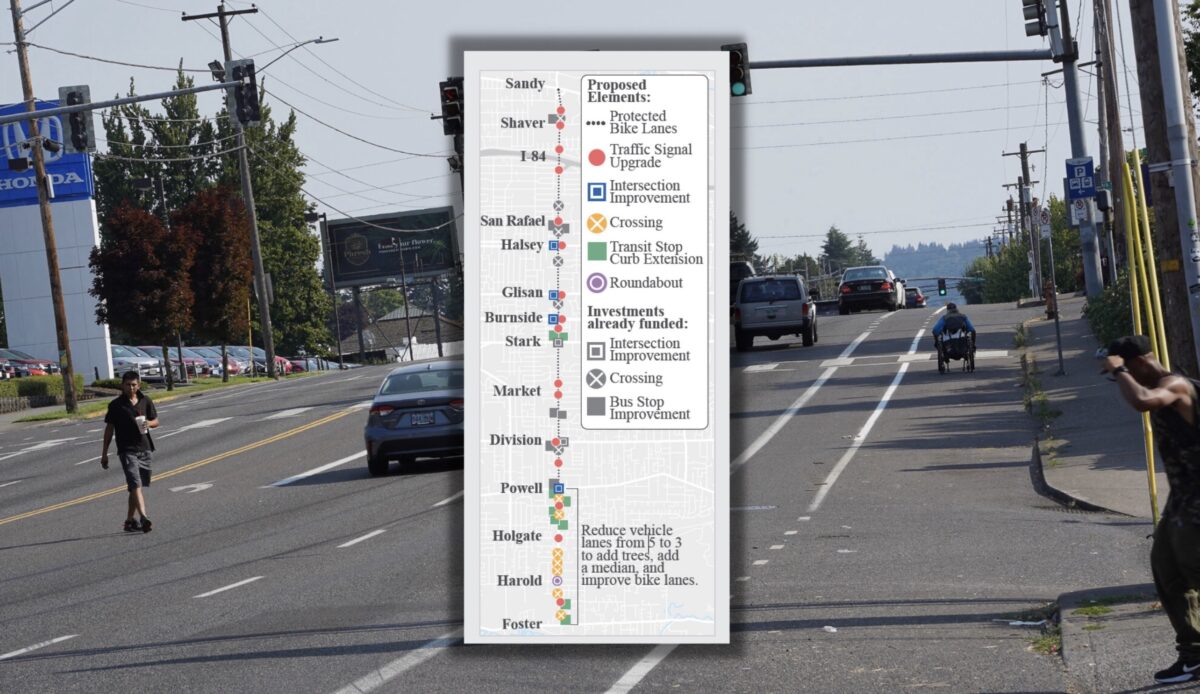
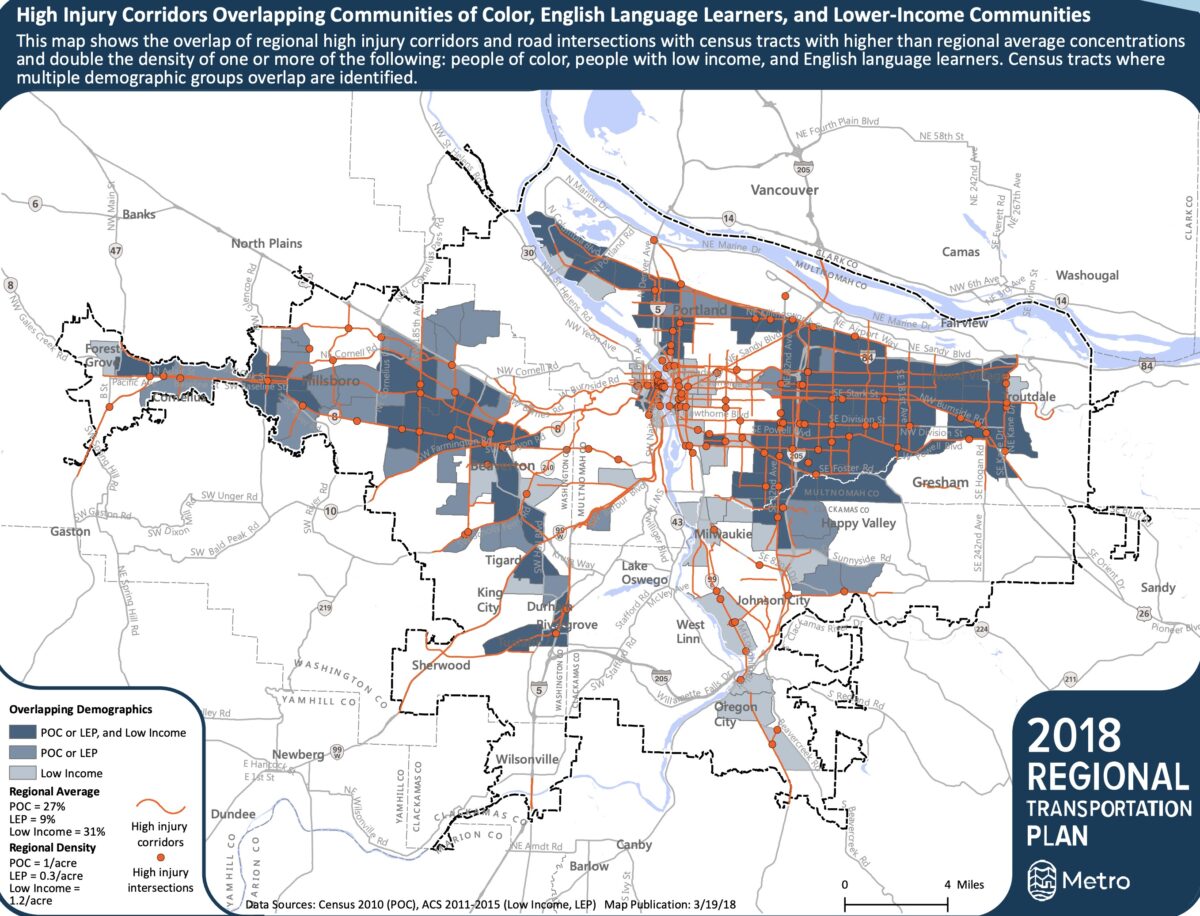
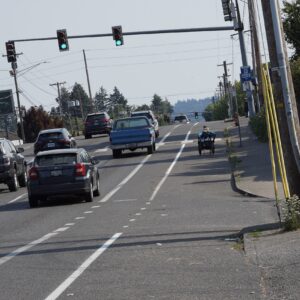
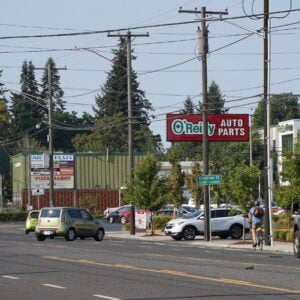
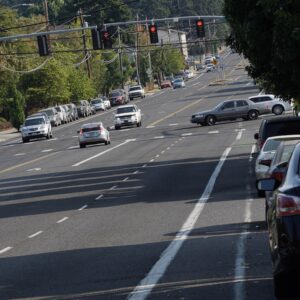

Thanks for reading.
BikePortland has served this community with independent community journalism since 2005. We rely on subscriptions from readers like you to survive. Your financial support is vital in keeping this valuable resource alive and well.
Please subscribe today to strengthen and expand our work.
The 73 is one of TriMet’s highest ridership routes, and seeing the possibility of bus lanes dwindle to just the occasional treatment, queue jumps, etc. is massively disappointing. PBOT has yet to really make a single “transit only” space in the city – at least not since the original transit mall in the 70s. Even on very wide ROWs like Grand/MLK (where there is obviously plenty of room), buses get thrown in with right turns and trucks (although the trucking/transit only lane is an interesting idea – but trucks rarely use it from what I’ve seen). The downtown Rose Lanes have bikes thrown in, or are very short.
And don’t get me started on the degradation of the Transit Mall. The addition of a whole car lane (and street parking) really is ridiculous. The MAX has to bob and weave, forcing lots of interactions with buses – rather than just staying on one side of the road (preferably the left, so bus stops can be on the right). It all reeks of transit infrastructure that is still unwilling to take anything other than the smallest amount of space away from private automobiles.
Worth remembering that faster more reliable bus service is also significantly cheaper! If a bus route runs at 15 minute frequency, and takes 75 minutes to run start to end, a 20% increase in travel speed would mean one less bus is needed to maintain the prior level of service. And while a 20% travel speed increase sounds like a lot, it’s actually fairly common for that to be the approximate difference between a rush hour timetable and an early morning time table (on the #12, runs take 60 minutes at 5:30 AM, and 75 minutes at 4:50 PM)
Comment of the week.
Any redesign of a four lane(+) street without dedicated bus space is a disappointment. Buses should have signal priority timed so that they see dedicated green lights and cross intersections at 15 mph.
As blumdrew says, faster buses solve a lot of problems. The 20% example noted would fix Trimet’s staffing problem, for instance.
Portland-area bus transit would be better served by abandoning downtown hub-and-spoke service altogether and focus on 15-minute or better frequent service on a cross-town lattice network of buses like the 72 or 73 instead, as Houston has done. If folks need to get downtown they can still use the light rail and streetcar, then transfer to the buses, bike or walk as needed.
I agree with this. So many north-south routes make weird detours for the sake of going downtown when they would be so much more useful if they just stayed on the East side.
I think that’s generally how things are trending, but downtown still will have a significant place in the transit world just owing to Portland’s historic development patterns and geography. Most of the most popular streets (especially in the close in eastside neighborhoods) are radial anyways, and have popular bus routes to boot.
I’ll be interested to see how TriMet makes good on their promise for a “high frequency grid” that they are looking to implement with the new service plan (something which I swear I’ve seen they claimed they did as early as the 80s before – can’t find that right now though). Right now in inner SE, it’s pretty bleak for the unlucky folks who live too far south to have any service on the #6. Bring back the original Bridge Transfer Line and extend it down Milwaukie! Run a bus in the 20s! Run the #70 after 7:30 PM!
The real truth of a transit systems effectiveness can pretty much always be found in the timetables, and I just am sick of having to deal with unreliable buses.
Well, Trimet does have to try and force people to ride the Max to drive up ridership numbers to justify the ridiculous amounts of money spent on it.
And yes, I commute on the Max and it was terrible before Covid, it’s way worse now. Buses are only a little better.
What do you mean it was terrible before Covid and worse now? I’m not on either daily but I’m on them often and think it’s fine. Every so often you see a kook but for as long as I’ve been taking transit, C-Tran as a kid in Vancouver starting in ’90 and TriMet as an adult, you see a kook. One time a guy was dry shaving on the Fourth Plain bus. Another time a guy got on the old Interstate bus with a sewer grate. Etc. Kooky stuff. But hey, that’s city livin’.
It was indeed terrible before Covid and I don’t ride it now, but can easily imagine how bad its gotten.For a year I commuted from East Hillsboro to Clackamas (and no I couldn’t afford to move closer) using only public transit. 4 transfers, two hours and a 15 minute walk at the end to get there and the same to get home. In the early morning jammed in like sardines with all the other wage slaves and then the liquid and chemically impaired from the night before would start to get on at Gateway and as the Green line went south it got worse. On the way home the train would be packed as well as we all tried to get home and then hit all the homeless and business types taking short hops downtown crowding in even more.
Not pleasant at all.
I do agree with you that it is simply city living and most not likely not fixed anytime soon which is why I was finally able to call it quits.
What do you mean by abandoning downtown hub and spoke service altogether? Maybe you mean to say “lets beef up north/south routes”. I take the 2/9/17 downtown, or towards downtown all the time. You’re totally aware most the big arterials in Portland go east/west. So what gives?
You are right, all the big arterial stroads go east-west, except those that go north-south like 122nd, 82nd, and all the other numbers, plus those silly diagonals like Sandy and Foster plus the ones in SW, and then there’s Broadway which changes directions. Many of the East-Wests don’t go to downtown at all – Columbia, Lombard, Powell, and Flavel for example, yet they serve many users and businesses. So the current bus system serves a city that no longer really exists – a smoky industrial city of 300,000 focused on a dying downtown core – but rather a galaxy of numerous town centers and places of employment in a growing city of 658,000. The 2 busiest bus routes, 72 and 73, never get anywhere near downtown at all. And 122nd reflects this.
Maybe fix the sidewalk under the east side of the railroad bridge might be a good start for getting people to walk in that area on 122nd. Having a very narrow space blocked by the constant growth of vines shows how PBOT really doesn’t mean it.
That street is notorious for right hooks. They should make all the lights no right on red with big light up signs and add advanced walk signals. I’d say about half of drivers ignore the non-lit signs. You’d still have all the driveways to deal with but it would be an improvement. Drivers just aren’t looking for pedestrians or cyclists around there.
They put in bike lanes/lights on Powell to fix that problem. I hate to lose all the parking spaces, but yeah, they need to do it all down 122nd too. It takes time.
So all the money that has been wasted on Division and Powell for bikers that don’t exist is crazy. The not turn right on red because of bike commuters. Go out there and count how many bikers. Portland is such a joke and can’t stand it, you should not be taking lanes away when it’s already not sufficient amounts
1) I use Division to get to work on my bike every day.
2) They just finished those projects less than a year ago. It’s well-documented that people take time to adjust their transportation habits.
3) They took away zero car lanes on Division.
4) No right on red also helps to keep pedestrians safer. Right hooks happen to people crossing the street too.
I’ll add that almost half of pedestrian fatalities in Portland occur in a crosswalks most of which the pedestrian had the right of way. Right on red is unnecessarily dangerous and based on how lights are timed typically saves the driver little or no time at all.
The streets need to be welcoming and safe for all users. Just because a bicyclist doesn’t ride the street today, doesn’t mean they won’t tomorrow.
So, curious, what are you doing to reduce your dependency on the automobile?
Some people were talking about this at work today. Like “oh here comes the city to ‘ruin’ 122nd.” What’s there to ruin? It’s an ugly and dangerous stroad, one of the worst places to be in the whole city – despite all of the great local businesses lining it. Maybe I only feel that way because I only really ride my bike on it. In my thoughts, the kind of deranged backlash to the Division project was only the tip of the iceberg.
At our local bike coop we have competitions for who can tell the most outrageous conspiracy theories, particularly regarding bike facilities, transit, and car parking.
Looks to me like they plan on making it harder for my daughter to get in or out of her apartment building just north of Holgate. The bus and bike improvements don’t help her at all, she has to drive to work at OSHU
I guess I can’t speak for you daughter, but I wouldn’t be so sure it will make it harder to get in/out of her apartment. Bus/bike improvements will (hopefully) make it so fewer people have to drive everywhere around there, which would improve traffic. Also, having a narrower road will make things safer by lowering typical travel speeds.
Traffic often is hard to predict, and people’s first intuitions are often wrong. It’s a chaotic system, governed by many many complex interactions. Sure, you may expect traffic to get worse but that’s not what’s observed in the real world.
https://safety.fhwa.dot.gov/road_diets/resources/pdf/roadDiet_MythBuster.pdf even the FHWA says that lane reductions mostly don’t have an effect on traffic conditions.
Oh no, the literal worst thing that can happen to anyone, a minor inconvenience!
Maybe she can use the new bike lanes for shorter, local trips?
Luckily for her the 17/Holgate crosses at Tilikum Crossing. Hop off there and walk like, what, a minute or two or three?, to the tram and she’s at work.